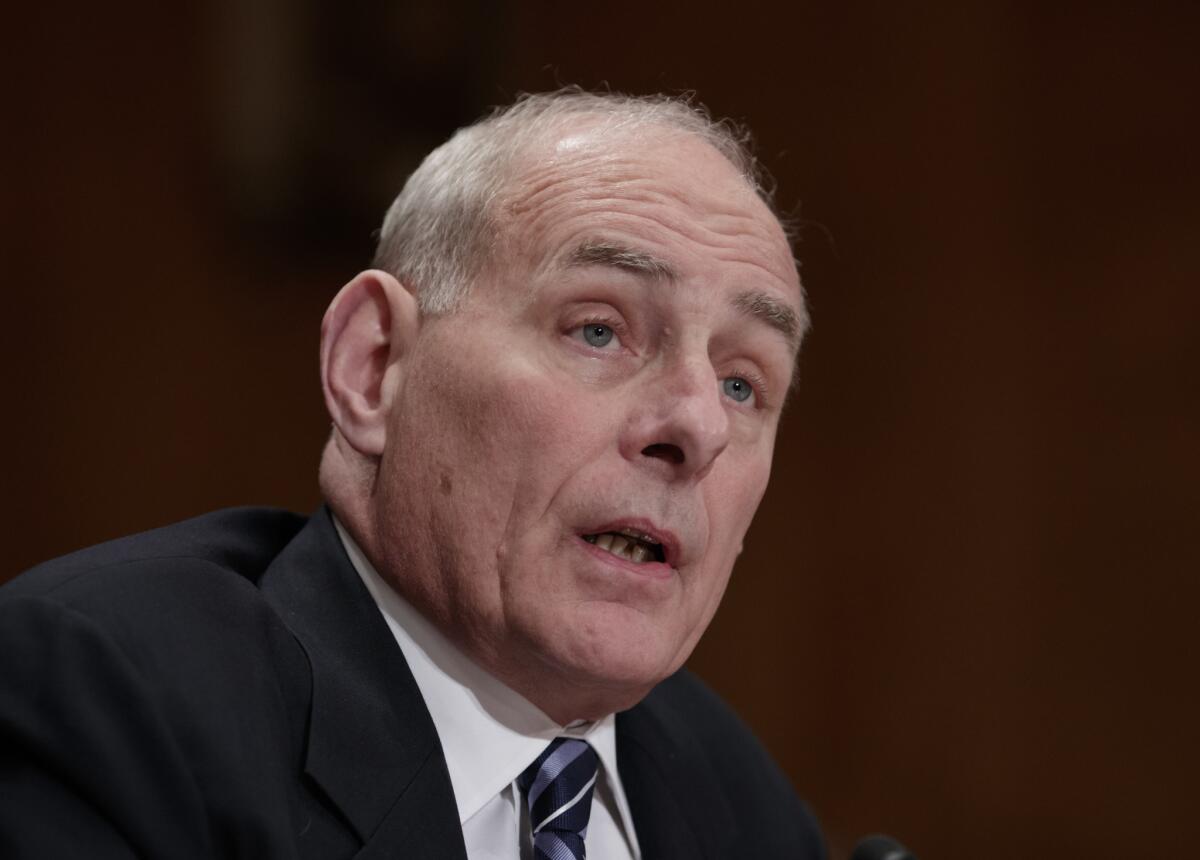Trump administration concedes border wall won’t be from ‘sea to shining sea’

- Share via
Reporting from Washington — President Trump’s central campaign promise — a “big, beautiful wall” along the border with Mexico — will not actually stretch across the entire border, Homeland Security Secretary John F. Kelly told a Senate committee Wednesday.
“It’s unlikely that we will build a wall or physical barrier from sea to shining sea,” Kelly testified before the Senate Homeland Security Committee.
“But … I’m committed to putting it where the men and women say we should put it,” he said, referring to the agents involved in immigration and border enforcement.
Kelly’s statement was the administration’s clearest official acknowledgment that there will be no wall along the entire border, something he and other officials have suggested somewhat less directly in other forums.
Throughout the campaign, Trump had insisted that the border wall would be a physical structure paid for by Mexico. His administration plans to request money for the wall from Congress. Trump still says he will find a way to force Mexico to reimburse the U.S. for the cost, something the Mexican government calls a nonstarter.
Kelly said many aspects of the wall remained uncertain, including the cost and the structure. Some estimates have put the cost from $12 billion to $38 billion.
“There’s no way I can give the committee an estimate of how much this will cost,” he said.
“I mean, I don’t know what it will be made of. I don’t know how high it will be. I don’t know if it’s going to have solar panels on each side, and what the one side’s going to look like and how it’s going to be painted, have no idea.”
Kelly, under questioning from Sen. John McCain (R-Ariz.), conceded that what the president refers to as the wall could be interpreted as a combination of drones, towers, fences, technology to detect tunnels and other electronic means combined with border guards — an approach that would not differ sharply from current policy.
“Yes, sir. In my view, the wall is all of that,” Kelly said.
Both under George W. Bush and Barack Obama, the U.S. has built many miles of additional fencing along the border that has significantly reduced crossings.
Officials at the Border Patrol union, which has considerable influence with Trump, have said that additional fencing is needed in certain urban areas.
Agents prefer fences to walls because a wall allows people to be hidden on the other side, agents have noted. They also have emphasized fences in urban areas to prevent people from crossing the border and quickly blending in with a city’s population. In less populated areas, surveillance and patrols work better, they have said, since a fence needs to be monitored to be effective.
Even as Kelly testified, the Trump administration touted new numbers on border crossings that it said vindicated its approach, including an effort to crack down on “sanctuary cities” and beef up security at the border.
U.S. Customs and Border Protection reported that 16,600 people were apprehended and deemed inadmissible at the southern border in March, a 35% decrease from the previous month and a 64% decrease from same month in 2016.
Twitter: @noahbierman
ALSO:
Trump removes Stephen Bannon from National Security Council in staff shakeup
At Trump’s EPA, going to work can be an act of defiance
Can the U.S. defend against a North Korean missile strike?
More to Read
Get the L.A. Times Politics newsletter
Deeply reported insights into legislation, politics and policy from Sacramento, Washington and beyond. In your inbox twice per week.
You may occasionally receive promotional content from the Los Angeles Times.











